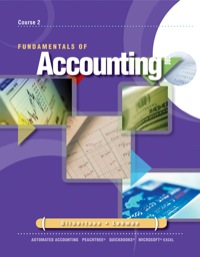Question
Which organization creates GAAP? 1. FASB 2. DOE 3. GASB 4. SEC For creditors, (i.e. those that lend corporations money) are interested in the following.
Which organization creates GAAP?
1. FASB
2. DOE
3. GASB
4. SEC
For creditors, (i.e. those that lend corporations money) are interested in the following. Pick all that apply.
Creditors are concerned in general with a company's cash flow
Short-term Creditors are concerned with liquidity
Long-term creditors are concerned with solvency
Short-term creditors are concerned with solvency
Answers 1,2, and 3
A company that has a high business risk (i.e. high earnings and cash flow volatility) should also have high financial risk. True or False
True
False
QUESTION 5
Equity in general (Equity analysts and shareholders of a corporation) are primarily concerned with a company's future earnings
True
False
QUESTION 7
In Chapter 1, which company & its auditors in Chapter 1 initially suggested that the company had been obliged to restate its financial results in response to a SEC advisory on rules for booking revenues. After the SEC objected to that explanation, the company conceded that its original accounting was simply not in accordance with GAAP for many years (i.e. they fudged their numbers).
1. Interpublic Group of Companies
2. None of the above
3. Lernout & Hauspie
4. REC
5. Microstratgey
QUESTION 8
If a company has:
Sales of $1 million,
Expenses of $300,000,
and pays dividends of $250,000
Should see an increase in Retained Earnings of?
300,000
None of the choices are valid
450,000
950,000
1,300,000
$1,000,000
700,000
QUESTION 6
CEOs of corporations prefer and like to issue stock to raise funds to finance a corporation.
True
False
QUESTION 10
A corporation exists for: Select all that apply (Book pages 3-5)
I. The benefit of its shareholders
II. All of the above
III. To educate the public about its financial condition
IV. Maximize its shareholders wealth
V. None of the above
QUESTION 11
In Chapter 1, Richard Zeckhauser and his associates corroborate the big bath hypothesis by showing:
that small earnings declines are more common than small increases.
that large earnings declines are as equally common as large increases.
All of the above
that large earnings declines are less common than large increases.
that large earnings declines are more common than large increases.
None of the above
Step by Step Solution
There are 3 Steps involved in it
Step: 1

Get Instant Access to Expert-Tailored Solutions
See step-by-step solutions with expert insights and AI powered tools for academic success
Step: 2

Step: 3

Ace Your Homework with AI
Get the answers you need in no time with our AI-driven, step-by-step assistance
Get Started


